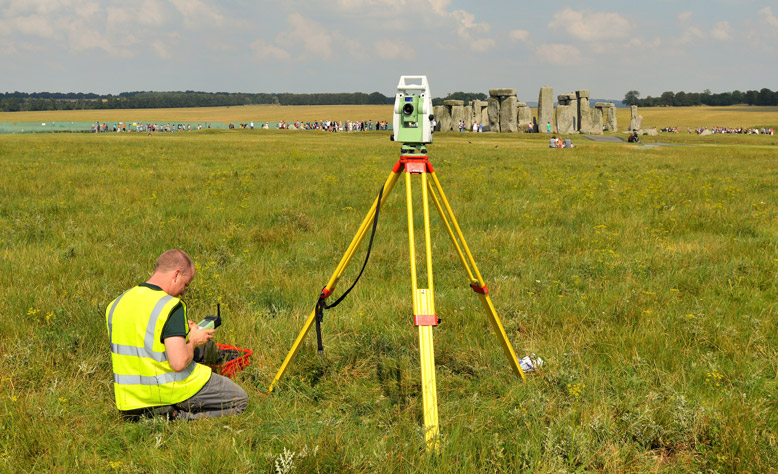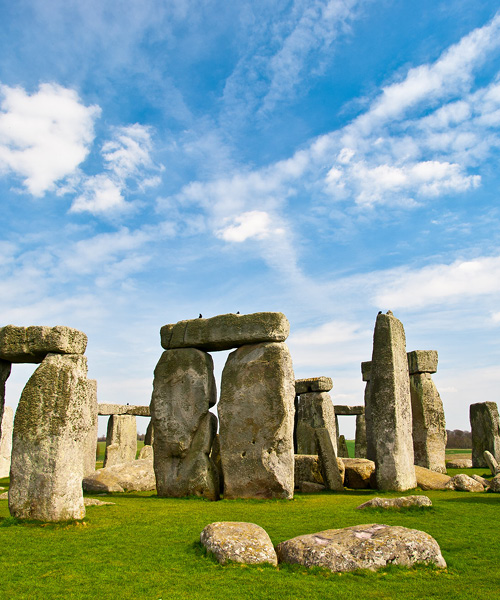Among the projects honoured as part of the Queen’s Anniversary Prize is Stonehenge Hidden Landscapes.
Here we take a look in more detail at what the project has achieved and what its impact has been.
Core to the School of Archaeological and Forensic Science’s approach is the questioning of orthodoxy. Stonehenge has been the subject of archaeological enquiry and exploration for hundreds of years and yet much of that enquiry has been centred on the monument itself.
The Stonehenge Hidden Landscapes project (SHLP) literally turned its back on the stones and realised that they stood in a vast area that had to provide context for the monument.
Because previous enquiry had focused on known sites, understanding the unsurveyed landscape and the ability of national curators to effectively manage this internationally important landscape through a period of major change was a challenge.
Discovering huge, previously unknown features
In order to support our national curators and heritage managers, Bradford, as part of an unprecedented, pan-European consortium including the Ludwig Boltzmann Institute in Austria, scaled up its approach in an unprecedented way to cover an area of 26.2 square kilometres and in order to search such an area effectively applied techniques that it had developed over a number of years. These included GPS-located collection of geophysical data, allowing for large-scale, non-invasive motorised collection of data capable of being applied on a large scale.
With their international and national partners, the Bradford team was able to view the landscape as an undivided, three-dimensional space. It also led to the discovery of huge, previously unknown structures and features. These included the massive pits within the greater Cursus, a series of complex timber monuments underneath existing sites, the identification of a Late Neolithic monument predating the bank and ditch of the Durrington Walls super-henge, and a vast shaft encirclement of that henge.
These discoveries have led directly to modified interpretations of the known monuments within the context of the newly discovered features and structures, together with new theories of the structure of the associated landscape.
The volume of data collected has made a fundamental contribution to knowledge of the Stonehenge landscape. In fact, the significance of the discoveries has been likened by the archaeological media to the discovery of the tomb of Tutankhamun. This contribution has been explicitly recognised by World Heritage Centre/ICOMOS, noting in the joint report on the World Heritage Site the crucial nature of the archaeological discoveries and the technical and methodological approaches used.
The mission wishes to underline the very high quality of research produced around Stonehenge ...including such projects as the “Stonehenge Hidden Landscape”... These have led to a substantial increase in our understanding of the monuments and the landscape…
United Nations Educational, Scientific and Cultural Organization (UNESCO)
Firing the imagination of news media and public
The decade-long work of the Stonehenge Hidden Landscapes project and the consequent significant change in our understanding of both the distribution of new monuments and knowledge relating to previously known monuments has influenced heritage estate management both at the site and nationally, has led to improved and enriched interpretation and presentation of the Stonehenge story, and has fired the imagination of news media worldwide, resulting in huge and ongoing public interest and, as a result, economic benefit though increased tourism.
The research has fed into heritage databases used to inform the management of the landscape, particularly in relation to planning. This has included many new entries in the Historic Environment Record, maintained by the Wiltshire County Archaeology Service, and the register of Scheduled Ancient Monuments, maintained by Historic England.

Reaching millions worldwide and influencing policy
The National Trust has stated that the project has helped in the overall management of the property and there is significant use of its ongoing discoveries by the Trust to ensure positive engagement with other bodies and institutions, such as the Army, which has relocated facilities immediately north of the site. Furthermore, the work of the (Stonehenge Hidden Landscapes project) has influenced the National Trust to significantly alter the way in which it investigates the whole of its estate. The Trust set up a remote sensing advisory group that ensures modern strategies developed by the project continue to be used on Trust properties, a significant development given that the Trust is the fourth largest landowner in the UK.
The project’s discoveries and their significance have changed the knowledge base upon which decision-making is undertaken, including in relation to the A303 tunnel scheme. The importance of the research for Highways England led to acquisition of the project’s data in advance of publication to help develop the archaeological evaluation and mitigation strategies for the A303 road scheme.
The continued media, and consequently public, interest in the discoveries made by the project has been both sustained and global in magnitude. A two-part BBC 2 mini-series about the Stonehenge Hidden Landscapes Project was broadcast several times and was seen by 7.6 million people in the UK. It was then screened by broadcasters in Spain, Italy, Greece, Cyprus, Bulgaria, Russia, Poland, Finland, Norway, China, Hong Kong, Thailand, Australia, and the USA. More than 300 newspapers and other news outlets covered the discovery at Durrington Walls, reaching people all over the world. Even football and technology magazines, and mobile phone and science fiction publications carried the story.
The sheer amount of publicity that the SHLP work around Durrington Walls generated was in my experience, almost unparalleled in the history of archaeology.
David Keys, Archaeology Correspondent, The Independent
Enriching our engagement with the past
The National Trust and English Heritage now present an enriched interpretation to visitors using the project’s research. The Stonehenge Visitor Centre uses the project’s information to tell the landscape story. For example, the discovery of a complex timber monument underneath the Amesbury 50 round barrow helped to inform reconstructions and audio-visuals of round barrows in the centre’s exhibition. More than nine million visitors have experienced these displays.
Award-winning archaeology
The Stonehenge project is a part of the projects honoured for the Queen's Anniversary Prize.
Find out more about our award and other sub-projects below.

